Pressure Points: Tips For Training To Play Under Pressure
Did you know this time of year can expose the strength of your training (both physical and mental)? For collegiate teams, the rigor of pre-season tournaments provides an anticipated test for athletes. College coaches want to expose athletes to an extra amount of games at the start for multiple reasons with two reasons being to test how athletes respond to varying levels of competition, and to see how athletes will handle the physical and mental fatigue that comes with many games stacked in a few days and shorter recovery times.
In several ways, the preseason is designed to mimic what postseason play presents—a lot of games with less recovery at varying levels of intensity and competition level. The preseason presents pressure from the sheer nature of the number of games that are played and is a great opportunity to build your pressure point skill set.
Had you thought about the preseason as an opportunity? Over the next few months, I will present some tips in chunks to help you prepare yourself to perform under pressure, so by the end of school season and leading into summer ball season, you are ready to meet the challenges ahead.
Why We Don't Perform Under Pressure
To help you understand how to train to perform under pressure, you need to understand why athletes often fail under pressure. There are three common reasons we don't perform well under pressure (Preston, 2023), and in this article, we're going to focus on one. (Don't worry! We will cover the other reasons in the coming articles.)
You're outcome-focused. You may be too focused on the outcome or results of the performance. When you are overly focused on the outcome, you make the outcome more important than it actually is, and you are missing the cues and process steps you want to accomplish to get a successful outcome. I see this issue in all areas of life with all kinds of people, so this isn't just an athlete issue.
Now, you may be asking, "Well, everyone tells me to set goals and work toward those," and that's true. Goal-setting is extremely effective for moving you forward (Jeong et al., 2023). The problem arises when you set a goal and keep your focus ONLY on the outcome. This hyper-outcome focus then limits your ability to think through the actions and behaviors you can do to achieve that goal in ways that are both feasible and reasonable for you.
Also, you may fall into the trap of believing that a single outcome is the only successful result, making it critical to you that you achieve that single goal instead of seeing value in other possible outcomes (e.g., that outcome becomes more important to you than it actually is to the situation/performance).
So, how do you help yourself keep situations in perspective so that you do not over-emphasize an outcome in pressure situations?
Try: Mental Zooming With SBR Goal-Setting Technique
You may have heard you want to focus on the process when you're working toward a goal, and this is true. The process is your "how-to" steps that define the actions and behaviors you can take to get you to a goal or outcome. Often, we become outcome-focused because we don't identify or articulate the "how-tos" or we set actions and behaviors that we are not really committed to doing.
One goal-setting framework that can help you identify your process steps in a way that considers your situation is the Situation x Behaviors = Result (SBR) model (Hanson, 2007). First, articulate the specific result (R) you want (your outcome). Second, identify your current situation (S). This step requires you to learn how to assess the environment you will be in while you're trying to achieve the result.
Your situation should include resources you have access to that can help you achieve the result, as well as resources that may be missing that could be helpful. Identifying your situation is an important step in the process, as it helps you think about your teammates, coaches, competitors, home life, and other things that could affect how you will achieve your desired result. Finally, the most important part—identifying specific actions and behaviors (B) you can do (given your situation) to achieve your desired result. Here's where the mental zooming comes in.
After you've identified the behaviors, zoom your focus IN on the Bs (actions/behaviors) for a while. Give yourself time to take action toward your R (result). After some time, zoom OUT and reexamine your result. Look at your S (situation) and see if anything has changed, take note of the progress (or not) you're making toward your result, and evaluate if you need to change your R (goal) and/or your Bs (actions/behaviors).
Make the necessary adjustments if you find some, then zoom back IN on the Bs. This is a cycle, so you will want to zoom out again to evaluate your progress briefly, then zoom in again on the Bs where your focus should stay the longest.
Really, you practicing zooming in and out on your goals can work for any goal-setting approach you use. The idea is to set your goal, identify behaviors and actions you will take to reach that goal, keep your focus on those, and zoom out occasionally to the outcome goal just to make sure you are on the path to reaching that goal.
This is just one approach you can take that may help you perform under pressure by shifting your focus to the process of the moment (versus the outcome in the moment). As with any mental process, you have to practice mental skills consistently in non-pressure moments to be able to experience success.
In the coming months, be on the lookout for more tips on how to perform under pressure. If you would like help with learning mental tools, I am taking new clients for the summer. Please email me at mmbLLC05@gmail.com to discuss.
Dr. Megan Buning is a Certified Mental Performance Consultant (C.M.P.C.) with over a decade of experience training the mental game.
References
Hanson, B. (2007). The SBR Model: Situation x Behaviors = Results. Athlete Assessments. Retrieved from https://www.athleteassessments.com/sbr-model/
Jeong, Y. H., Healy, L. C., & McEwan, D. (2023). The application of goal setting theory to goal setting interventions in sport: A systematic review. International review of sport and exercise psychology, 16(1), 474-499.
Preston, C. (2024, February 27). How to perform under pressure [YouTube]. CEP Mindset. Retrieved from https://www.youtube.com/watch?v=2-T64_HJwGA


























